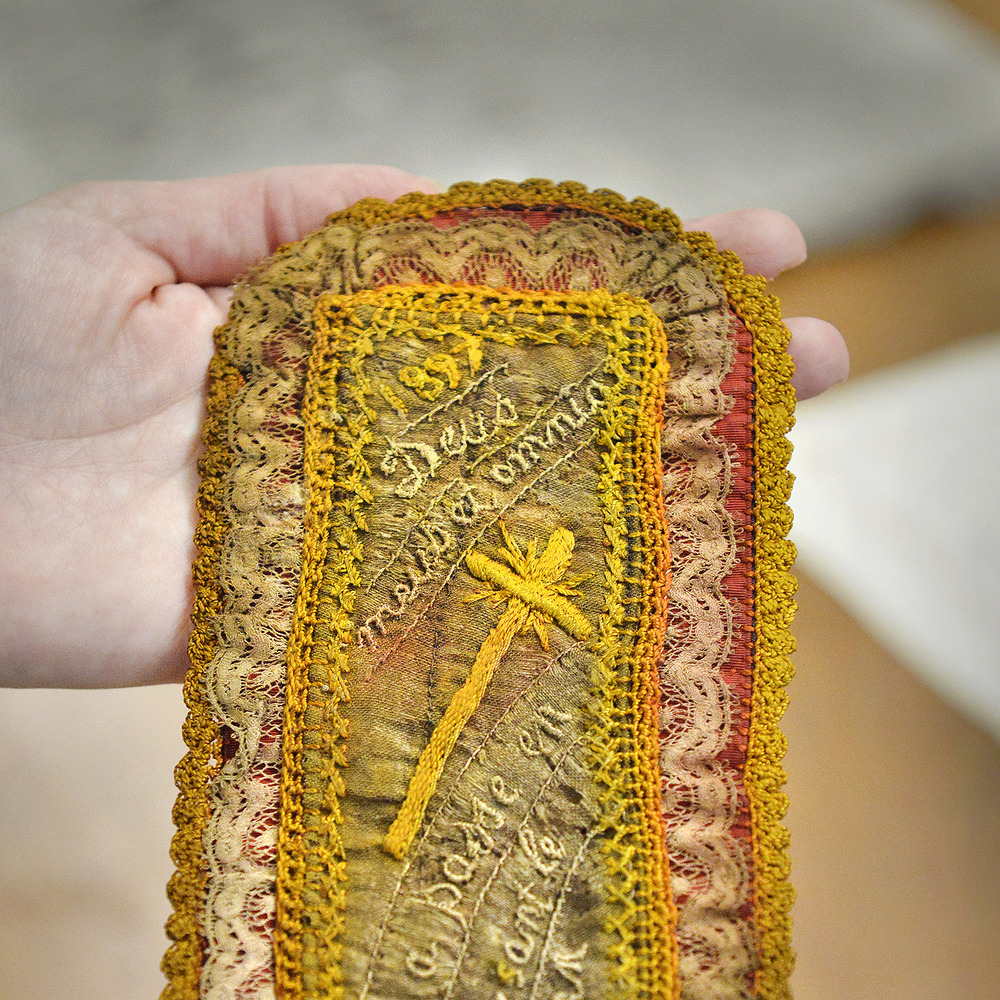
A platform that encourages healthy conversation, spiritual support, growth and fellowship

NOLACatholic Parenting Podcast
A natural progression of our weekly column in the Clarion Herald and blog

The best in Catholic news and inspiration - wherever you are!
New exhibit at Old Ursuline Convent Museum to celebrate city’s love for the ‘Eternal’
-
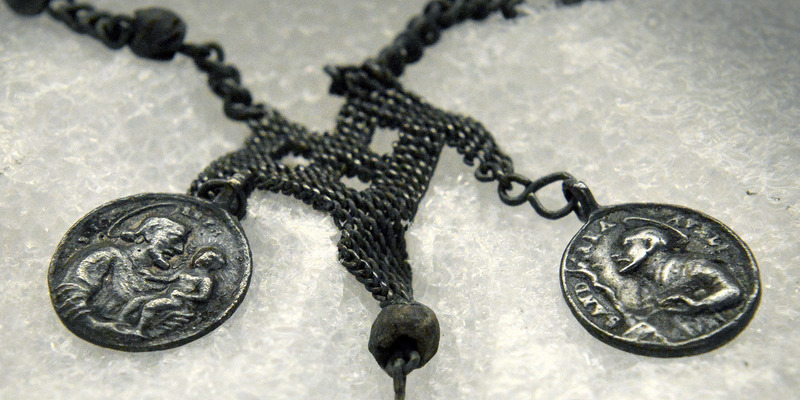
Photos by Frank J. Methe, Clarion Herald; images of artifacts found at St. Peter Street Cemetery (including the one above) appear in this article courtesy of the Louisiana Department of Justice, Lands & Natural Resources Civil Division.
By BETH DONZE
Clarion Herald
A new exhibit highlighting the uniqueness and diversity of New Orleans’ Catholic cemeteries, burial practices and mourning traditions will open this month at the Catholic Cultural Heritage Center – the French Quarter venue commonly known as the Old Ursuline Convent Museum.Entitled “Eternal Life,” the exhibit will offer free admission on its formal opening date of Sept. 9, from 10 a.m. to 2 p.m. at 1112 Chartres St. Tours will be given every hour from 10 a.m. to 1 p.m., and light refreshments will be provided throughout the day. The hope is that
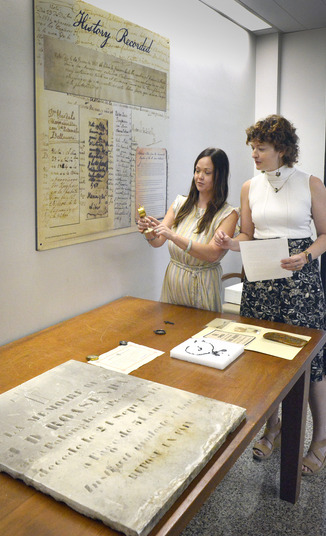 visitors leave with a better understanding of how Catholics in New Orleans have found joy, beauty and comfort, even as they face bereavement, said Kimberly Johnson, who helped curate the exhibit as director of the archdiocesan Office of Archives and Records.
visitors leave with a better understanding of how Catholics in New Orleans have found joy, beauty and comfort, even as they face bereavement, said Kimberly Johnson, who helped curate the exhibit as director of the archdiocesan Office of Archives and Records.“(The exhibit) celebrates the sacred beauty and history of our New Orleans Catholic cemeteries by highlighting, in art and symbolism, the lives and witness of those who have gone before us,” Johnson said.
Cemetery symbolism
A video, composed primarily of drone footage, will provide a literal “overview” of New Orleans’ 12 Catholic burial grounds. A map featuring pop-out photos of each Catholic cemetery will geographically orient visitors, and boards with explanations of the types of tombs built locally and on the city’s culturally rich “society tombs” will also be on tap.
Symbols commonly incorporated into the architecture of Catholic cemeteries, including some lesser-known symbols such as grapes and lambs, will be examined beyond their decorative appeal. For example, the image of a willow tree was a popular symbol of mourning in cemeteries in the 19th century, given the willow’s “weeping” branches.
“We’ll have a picture and an explanation of each symbol, so when people go to the cemetery, they’ll understand the meaning of the symbols,” Johnson said.
Nearby, a separate display will examine the genealogy of celebrated architects James Gallier Sr. (1798-1866) and his son James Gallier Jr. (1827-1868), whose achievements include the Pontalba Apartments, St. Patrick Church and the eponymous Gallier Hall, which served as New Orleans’ City Hall from 1853-1957.
The Galliers’ story will unfold through sacramental records, such as the marriage record of James Gallier Jr.’s marriage in the Ursuline Convent chapel, and cemetery records documenting the transfer of his remains from his in-laws’ tomb in St. Louis Cemetery No. 1 to their present location within the Gallier family tomb in St. Louis Cemetery No. 3.
The existence of enslaved people in the Gallier family’s household is documented in the “Slave Schedule” accompanying the 1860 Federal Census, and in baptismal records of two enslaved children at St. Mary’s Church, located next to Old Ursuline Convent.
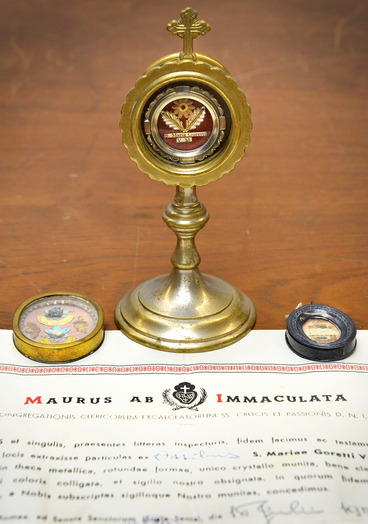 Saintly collection
Saintly collectionAnother whole room will be dedicated to the display of more than 20 reliquaries – special receptacles built to house saintly relics. Donated by the Carmelite nuns, the reliquaries range from the size of a quarter, to one that holds relics of multiple saints and measures in at 2-by-3 feet. One of the sacred objects contains a first-class relic of St. Maria Goretti.
“We have some of the paperwork that goes with the relic itself, and we’ll have that on display as well,” Johnson said. “Part of what you’ll learn in that room is the difference between first-, second- and third-class relics, and we’ll have examples of each.”
Respect for the dead
Yet another room will feature photographs and explanations of New Orleans’ celebration of All Saints’ Day and All Souls’ Day – and the differences between the two feasts. Newspaper advertisements from 1876 reveal that mourners were expected to dress in their best attire while sprucing up and visiting their loved ones’ graves on All Saints’ Day.
“For those who could not afford to purchase a whole new outfit, some stores even offered rentals of dresses, hats, jackets and children’s clothes,” Johnson said.
 A display of tools commonly used to clean tombs will be arranged near an actual cemetery tablet on loan from New Orleans Catholic Cemeteries (NOCC). The hand-carved tablet, which commemorates the life of a circa 1795-born Italian man named J.D. Roasenda, was recently reunited with its tomb through NOCC’s ongoing Lost Tablet Project.
A display of tools commonly used to clean tombs will be arranged near an actual cemetery tablet on loan from New Orleans Catholic Cemeteries (NOCC). The hand-carved tablet, which commemorates the life of a circa 1795-born Italian man named J.D. Roasenda, was recently reunited with its tomb through NOCC’s ongoing Lost Tablet Project.Finds from vanished site
Other items of interest at the new exhibit will include:
• A trio of artifacts uncovered during the 1984 excavation of St. Peter Street Cemetery, founded circa 1724 as one of the city’s first Catholic cemeteries and once bounded by North Rampart, St. Peter, Burgundy and Toulouse streets. Finds at the St. Peter Street Cemetery (a site that closed in the 1790s with the establishment of St. Louis Cemetery No. 1 in 1789) include a crucifix, a medallion picturing Christ and a rosary embellished with mesh metalwork and medals of
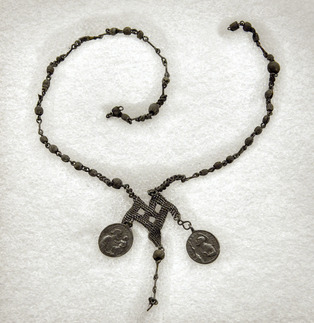 Sts. Andrew, Joseph, Camillus and an unidentified figure.
Sts. Andrew, Joseph, Camillus and an unidentified figure.“These are pieces that were found in the casket of an individual who was in his early to mid-40s. He was of African descent and was buried sometime between 1747 to 1775,” Johnson said.
• Mementos of Dutch-born Archbishop Francis Janssens, who led the Archdiocese of New Orleans from 1888-97. Two of those items, discovered inside a box that had lain undisturbed at the Old Ursuline Convent for more than a century, are:
– A mother-of-pearl medallion from Archbishop Janssens’ native Holland, into which the owner placed the archbishop’s picture.– A segment of the archbishop’s duster – the coat he wore to protect his clothes during rail journeys. Embellished with intricate crewel work, the maker – presumably a devoted Catholic woman – embroidered two messages on the swatch of fabric: The Latin for “My God and All”; and “He spent his life doing good,” written in French.
“Eternal Life” is a joint effort of the Catholic Cultural Heritage Center, which is under the administration of St. Louis Cathedral; the Office of Archives and Records; and New Orleans Catholic Cemeteries. For museum opening hours and ticket information after the Sept. 9 free-admission day, visit www.oldursulineconventmuseum.com.





